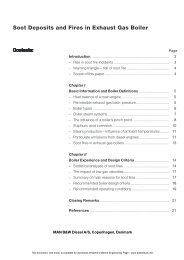Fire on Board the Liberian Passenger Ship Ecstasy, Miami, Florida ...
Fire on Board the Liberian Passenger Ship Ecstasy, Miami, Florida ...
Fire on Board the Liberian Passenger Ship Ecstasy, Miami, Florida ...
- No tags were found...
You also want an ePaper? Increase the reach of your titles
YUMPU automatically turns print PDFs into web optimized ePapers that Google loves.
Factual Informati<strong>on</strong> 30 Marine Accident Reportaddress <strong>the</strong> reliability problems with <strong>the</strong> high-speed breaker auxiliary voltagesupply arrangement that was installed aboard <strong>Ecstasy</strong>.In its resp<strong>on</strong>se, LR states:The high speed circuit breakers to which you refer are those <strong>on</strong> <strong>the</strong> motor side of<strong>the</strong> cycloc<strong>on</strong>verters through which <strong>the</strong> motors receive <strong>the</strong>ir power. The voltage(s)supplied from MS 21 appear, from <strong>the</strong> manufacturer’s data, to be primarily for <strong>the</strong>electrical closure of <strong>the</strong> circuit breakers.…after this fire, we were informed that <strong>the</strong> voltage supply from MS 21 is alsoused, internally within <strong>the</strong> cycloc<strong>on</strong>verter, to provide a “circuit breaker closed”signal in order to “enable” <strong>the</strong> drives to start and to c<strong>on</strong>tinue operating.The details of <strong>the</strong>se internal c<strong>on</strong>necti<strong>on</strong>s were not provided to LR during LR’splan approval, and LR’s surveys of <strong>the</strong> vessel’s c<strong>on</strong>structi<strong>on</strong>. Therefore, LR wasnot aware, prior to this casualty, that if <strong>the</strong>se cables were burnt through propulsi<strong>on</strong>would be lost.LR receives “design” plans for c<strong>on</strong>siderati<strong>on</strong> at or before <strong>the</strong> time of c<strong>on</strong>structi<strong>on</strong>of <strong>the</strong> vessel. It is <strong>the</strong>se plans that our surveyors review and stamp “approved”against applicable classificati<strong>on</strong> requirements. Up<strong>on</strong> completi<strong>on</strong> of c<strong>on</strong>structi<strong>on</strong>“as built” plans are forwarded to LR for record purposes.We have checked <strong>the</strong> <strong>Ecstasy</strong> design plans approved by LR at <strong>the</strong> time ofc<strong>on</strong>structi<strong>on</strong> and <strong>the</strong> “as built” plans forwarded to us for record purposes. Nei<strong>the</strong>rshow <strong>the</strong> detailed matters referred to in your letter.There have been no rule changes made since 1987 which address specifically highspeed breaker auxiliary voltage supply arrangements similar to those installedaboard <strong>Ecstasy</strong>. However, based <strong>on</strong> <strong>the</strong> experience gained over <strong>the</strong> years of whatwas in 1987 an innovative design, <strong>the</strong> Rules have been changed to take intoc<strong>on</strong>siderati<strong>on</strong> comm<strong>on</strong>ality of electrical supplies.U.S. Coast Guard Examinati<strong>on</strong>s. The United States requires that ships thatembark passengers from U.S. ports be examined by <strong>the</strong> Coast Guard for “substantialcompliance” with <strong>the</strong> c<strong>on</strong>structi<strong>on</strong>, equipment, and safety requirements of SOLAS. TheCoast Guard examinati<strong>on</strong>s are referred to as C<strong>on</strong>trol Verificati<strong>on</strong> Examinati<strong>on</strong>s (CVEs).These examinati<strong>on</strong> procedures are c<strong>on</strong>tained in <strong>the</strong> Coast Guard’s Navigati<strong>on</strong> and VesselInspecti<strong>on</strong> Circular (NVIC) No. 1-93, which provides guidance regarding examinati<strong>on</strong>sfor foreign cruise ship operators. The examinati<strong>on</strong> process involves three phases: an initialCVE, which is a plan review of new or existing vessels; an annual CVE, which is a reviewof <strong>the</strong> vessel’s firefighting, lifesaving and emergency systems; and a quarterly CVE,which is a safety review of <strong>the</strong> vessel’s operati<strong>on</strong>s. As of July 1,1998, <strong>the</strong> Coast Guard’sexaminati<strong>on</strong> for passenger vessels included Internati<strong>on</strong>al Safety Management (ISM) Codeprovisi<strong>on</strong>s, which are discussed later in this report, under “Internati<strong>on</strong>al SafetyRequirements.”
















